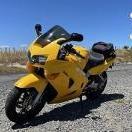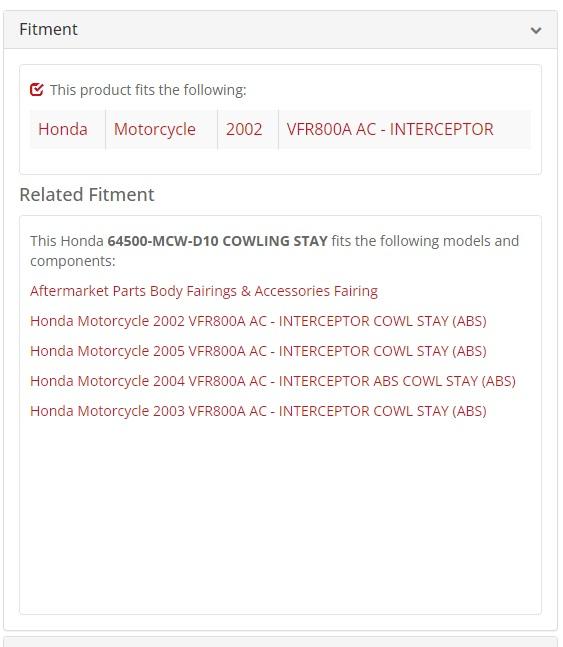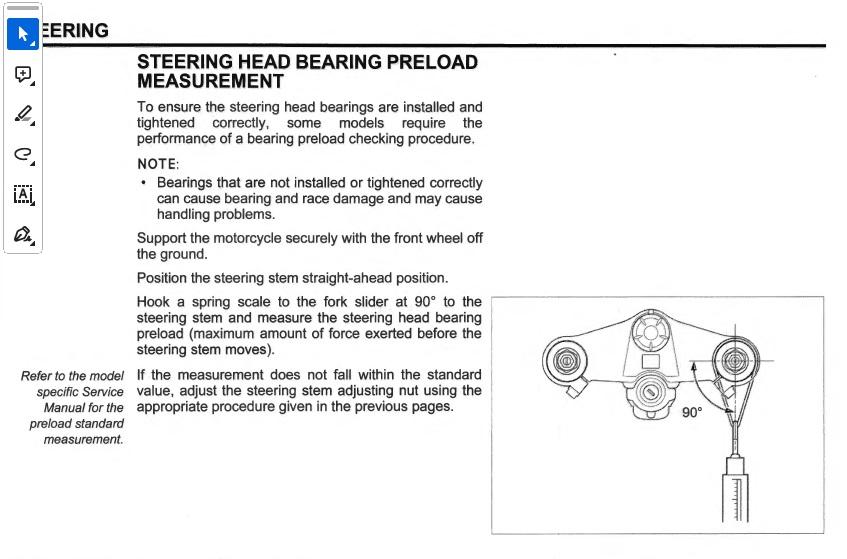-
Posts
1,804 -
Joined
-
Last visited
-
Days Won
59
Content Type
Forums
Profiles
Gallery
Blogs
Downloads
Events
Everything posted by Terry
-

Rear brake doesn’t work after front pad change
Terry replied to LEGEND's topic in Maintenance Questions
Did you also replace the back pads? I did this once and caught the pad on the pad spring; that pushes the pad back off the disk and makes for long travel even though it is well bled. -
Yep, the same way you blow up a bus. A more delicate soul might employ a compressed air line but honestly, if you are that risk-averse then motorcycling may not be for you.
-
You may need to find where the small coolant hoses branch off and blow through there. Wax units are very common on FI bikes prior to RBW throttles and will be found on loads of bikes. My 2005 ST1300 has one and that model was produced from o2 to 2012. The subsequent VFR1200 moved to RBW and relies on the ECM and the throttle stepper motors.
-
As a suggestion, you may have a blockage in the thin water tubes that lead to/from the wax unit. This means the wax unit does not see the high water temps and so keeps the idle high even when the coolant is hot. Eventually heat soak from the engine should allow the idle to drop but it might take a while. If you’re lucky you maybe able to blow the blockage clear without major surgery.
-
I suspect the majority of failures are blockages in the water hoses leading to/from the WU that prevent it from chasing the idle down promptly as the water heats up.
-
THe VF400FII fairing and the 86 tail are a great match, I love it. I also agree with Captain, the twin headlight RC fairing is not right.
-
That looks like a label that belongs on any coolant concentrate based primarily on ethylene glycol. Did you know that water will boil at 102C even with a decent working radiator cap that holds 1.1 Bar? That is awfully close to the fan cycling temperature, so it seems extremely likely that you could start boiling the coolant as soon as you get slowed in traffic, if you used pure water. Boiling creates steam and that blows gas through the coolant reservoir and pukes out the contents. I don't think I would ever use straight water in my bike.
-

Will a 2006 wiring harness fit a 2002 VFR?
Terry replied to styran's topic in Sixth Generation VFR's
If you look on the Partzilla site it does actually show which other models each part fits. In the case of the 2002 stay it is shown as fitting the 02, 03, 04 and 05. So the answer is YES!- 4 replies
-
- 1
-

-
- electrical
- wiring harness
-
(and 1 more)
Tagged with:
-
While I agree with the comment in principle (which I would restate as the specific heat of ethylene glycol is half that of water, hence it takes less energy to raise a water-glycol mixture by a degree than pure water) there are other beneficial effects from the presence of glycol, namely it reduces the freezing point of the mixture so makes it less likely for the liquid to freeze (and expand and cause mechanical damage) while the bike is parked up, and it increases the boiling point so the cooling system can still operate at higher temperatures without spewing steam and coolant out of the breather. The mixed coolants also provide corrosion resistance. I stick to the recommended 50:50 mixture recommend by Big H. My '99 also runs happily through a New Zealand summer at around 78°C under all throttle conditions as long as there is good radiator airflow. My opinion is that the limitation of the VFR cooling system is more likely to be the rate of heat transfer from the hot surface of the radiator to the air than the rate of heat absorption from the hot engine to the coolant, hence the coolant used won't actually affect the running temperature of the bike. Using pure water will increase the heat-up time from cold, and will slow the rate of rise when the bike is stuck in traffic, but won't actually change the peak temperature that is ultimately reached. YMMV.
-
The bars are unique to the VFR800 98-01 years based on the part number cross-reference. You definitely can't use any off the 2002 onwards as they have larger diameter (43mm) forks. An earlier year (88-97) VFR will fit but the locating peg (into the triple clamp) will probably need to be removed and the locating holes for the switch pods may be differently located.
-
Having replaced the thermostat on my yellow 99 last year I can only endorse what everyone else has said: 1. Yellow VFRs are beautiful 2. Changing the thermostat is very painful and you will only want to do it once 3. For reason 2, just get the OEM part.
-
Here's the article. Motorcyclist - September 2014 Reader - ZINIO5.pdf Motorcyclist - September 2014 Reader - ZINIO4.pdf Motorcyclist - September 2014 Reader - ZINIO3.pdf Motorcyclist - September 2014 Reader - ZINIO2.pdf Motorcyclist - September 2014 Reader - ZINIO1.pdf
-
That is our classic "chip-seal" and as you say it is grippy as hell but also pretty abrasive; that, and my carefree approach to cornering, are probably why I never get very good mileage out of my tyres. This is 7000km on a pretty decent Michelin Road, plenty of straightline life left but down to the wearbars on the shoulders. Our chipseal quality is sadly getting worse as the bitumen binder being used seems to be very inferior lately; it gets hot, then the stone chips either get pushed out or sink through, and you are left with big patches of scary, glassy tar that is dodgy when dry and lethally slippery when wet.
-
That's a really neat part of the country. I did the Burt Munro rally trip with a mate in 2018 on my ST1100 and spent a full day doing a lap of just Southland; it is glorious in sunny weather.
-
This was my other ride on January 2, I bounced out of bed at 0430 and hit the road north to Cape Reinga, which is just like Nordkapp or the far end of the Dalton Highway as it is as far north as I can go without swimming. Actually it is only 434km from home so I was there by 10am, had a quick look around and then hit more interesting roads on my way back home, which took another 6 hours. Just for a bit of sympathy, it did actually get quite cool on the way north and I was tempted to turn on the heated grips when it hit 9C, but the weather reached a toasty 26 later in the day...
-
Well it is mid-summer here, and the roads are dry and clean. I took Bumblebee for a 300km jaunt along my favourite north Waikato twisty roads. I enjoyed the sublimely well-engineered masterpiece that is the 1999 VFR800; the coolant stayed nice and steady at around 78, the linked brakes were doing their thing and providing plenty of power, the suspension managed the worst of the bumps with the requisite combination of control and comfort (that's what you get with a Nitron shock and Racetech fork bits) and the Sargent seat cosseted my delicate bits gently!
- 22 replies
-
- 10
-

-
In my limited experience, Michelins are usually a more "playful" feeling tyre that has better turn-in that say a comparable Bridgestone. There's probably a trade-off for stability but I haven't had any issues. As Mohawk says, steering feel is very subjective, and has an awful lot to do with weight distribution and geometry, not just tyres. I've been running Pilot Road 6s on my current bikes, but they do feel more "sluggish" on my VFR800, whereas the ST1300 and MT10 feel more eager to turn-in on them. With your Z900 I would first check that the recommended pressures are used, then look at the suspension sag and make sure you have about 1/4 to 1/3 sag at both ends with you onboard. You can get some change in steering speed by tipping the bike on its nose more i.e. by adding preload at the back and/or softening at the front, or slipping the forks up through the triples a little. At the end of the day, a set of new tyres might be all you need, and I can vouch for the Road 6s although due to where/how I ride, I can't comment on straight-line mileage...
-
The best way is to just loosen the bleed nipple and allow fluid to push out as the piston is pushed home. That avoids pushing any manky fluid back up the line to the master. Better still, clean around the piston first (an old shoelace dipped in brake fluid works well) so you don't jam more crud under the seal. Finish the job by pumping lots of nice fresh fluid through the system and bleeding any air. There are two nipples on each calliper, one for the centre piston, the other for the outer pistons in each. There is a specific bleeding sequence for the linked brakes, and the centre front pistons are driven from the rear master.
-
The actual torque on the adjusting nut will differ whether you have the original bearing (which I assume is a ball-type) or aftermarket tapered rollers. The latter hardly need much more than finger tight.
-
I have a Pyramid Plastics hugger on mine, also a surprisingly flimsy piece that has seen some tyre-hugger interaction in its life...Has a bracket attached to the brake line bracket, and is moulded to sit atop the swingarm at it's leading edge. The Pyramid instructions show a loooong cable tie looping through a couple of slots on the leading edge of the hugger and wrapping right around the swingarm in front of the tyre and through the shock tunnel.
-
If you were looking to take some play out of the bearing, then my inclination would be to tighten the bearing by hand until it starts to build up friction, then back it off until it frees up. But to do that you need to suspend the front end; from reading previous Honda manuals they do say to use a torque wrench but then usually add that you do a steering force check to make sure the bearing is moving freely. I can say from previous experience that an over-tightened bearing makes for an interesting experience as the bike loses that easy self-steering ability, and straight line and cornering move from analogue to digital...
-
All the weight of the bike will be supported through the bottom triple in any case, so I see no reason not to remove the top clamp while on the sidestand. However...it is hard to judge the steering bearing friction unless the front wheel is off the ground. Can you borrow a jack out of a car and lift perhap under the front of the engine case right side to get the wheel airborne?
-
Definitely 10mm and a reasonably fine thread (1.0mm?). I'm not at home otherwise I'd measure it properly, sorry. I have a 10mm x 60?mm coarse thread bolt, and I can screw that into the cartridge rod lock nut gently, which gives me something to grab hold of.
-
Check the fuel tank overflow hose is properly connected; from memory this can come adrift and drop down onto the exhaust headers near the back wheel.
-

New OEM clutch pack. Clutch not engaging
Terry replied to afinepoint's topic in Sixth Generation VFR's
Definitely should be no need to replace the master cylinder, and actually if the master piston is not leaking you probably don't need to replace any parts. Just a full disassembly and thorough clean and inspection. In the floor of the master cyinder is a small metal plate that sits into the main intake port, when you pick that out you will see the tiny relief port below. The metal plate's function is to stop a jet of brake fluid exiting the master when the cap is off during bleeding. Make sure this port is clearly ejecting fluid as the lever is pulled.









